|
 |
Louvre-DNP Museum Lab Customer Center
Tel: +81 (0) 35435 0880, Monday to Friday, 9 a.m. to 6 p.m. Closed on Saturday,Sundays and public holidays. |
|
 |
|
 |
 |
 |
 |
 |
 |
A touch panel with an operational feel enhances the interaction feeling |
 |
 |
|
| On conventional displays, the user simply presses buttons on a flat screen without feeling anything. By incorporating a force feedback panel that stimulates the fingertips via vibrations, the visitor will actually feel that the operation has taken place. As operations take place while the computer confirms that it has recognized the contents of the manual operation, we can expect an unprecedented interactive sensation. |
 |
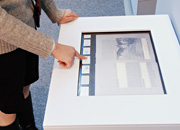 |
|
 |
 |
 |
 |
Immersive display reproducing the sensation of perspective |
 |
 |
|
To give the impression of actually entering into a painting, Museum Lab introduces a dedicated immersive display, which uses 2.5D technology. By associating "scenes” drawn in two dimensions and an interactive projection, this visual effect enables the visitor to perceive the relative disposition of the painting's elements in the three-dimension space they occupy.
The issue of reproducing perspective in the middle ground that occurred during the Third presentation was orchestrated by means of a dedicated three-screen system called CAVE which provides a panoramic view of a wide visual field. The Fifth presentation, uses the “texture gradient” effect whereby depth can be perceived from changes in the pattern of the surface texture of the wall or floor. A dedicated system links the floor tiles in the painting with the projected image on the actual floor in order to reproduce the reality of an indoor setting.
When infrared sensors detect the movements of users and their position in the display, rendering takes place immediately and the appropriate “scene” is projected. |
 |
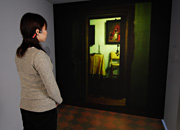 |
|
 |
 |
 |
 |
An ultra-small imaging system using a selective reflection-type hologram browser and ultra-small projector |
 |
 |
|
This imaging system consists of a projector using a LED light source. Ultra-small in size and generating no heat, it projects images onto a selective reflection hologram embedded into an optical prism 3.5mm thick, sending to the naked eye specific wave lengths reflected on the hologram screen in addition to other external visible light.
This feature allows clear visual communication of information, so that the computer image can be seen to overlap in the visual field of the visitor.
* A selective reflection-type hologram film is a film that reflects only a specific RGB (Red Green Blue) wavelength area.
* The holographic see-through browser is used with the product cooperation of Konica Minolta Opto Inc. |
 |
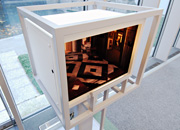 |
|
 |
 |
 |
 |
Augmented Reality (AR) route guide |
 |
 |
|
The AR route guide system that made its appearance in the Fourth presentation was developed using an UMPC (ultra-mobile PC). Visual marks detection enabled it to display 3DCG animations which guide the user in the course of his visit in the presentation space and deliver explanations about the exhibits.
The Fifth presentation is marked by the appearance of an AR guide using a smart phone (cell phone). The development of a guidance system using a mobile phone with limited processing capacity means that, in the future, visitors will also be able to use the AR guide on their own mobile phones. Operation of the guidance system will therefore be possible without restrictions imposed by the number of terminals available at Museum Lab. |
 |
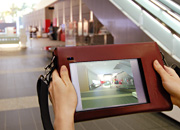

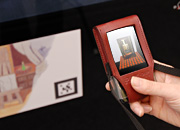 |
|
 |
 |
 |
 |
A multilingual system for a high definition and high audio quality movie theater |
 |
 |
|
| The movie theater offers a multilingual system whereby a second language can be delivered with the same playback timing as the onscreen images and main language. This could take the place of subtitles in museums equipped with a movie theater. While maintaining a highly realistic acoustic field of high audio quality supplied by speakers in the theater, a combination of bone conduction headset, audio guidance, and wireless LAN makes it possible to offer more than one secondary languages with no lapse in playback timing. |
 |
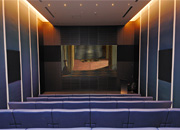 |
|
| The basic Museum Lab equipment. |
| An autonomous audioguide allowing visitors to concentrate on observation of the exhibits. |
| The audioguide available at Museum Lab proposes a commentary that is automatically generated, allowing visitors to concentrate on the exhibits and multimedia contents. Thanks to a bone conduction headset, visitors can listen to the guide and talk to the people around them at the same time. |
 |
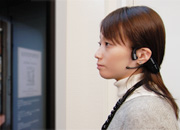 |
|
| A flexible real-time guidance system, using an electronic ticket. |
| The Museum Lab guidance system uses RFID electronic tag technology, which makes it possible to identify each visitor and satisfy individual needs: listening to a commentary in a specific language, keeping a record of an individual visit. When a visitor is detected in front of a device, a server identifies (in real time) the language he or she selected at the reception desk, and simultaneously generates a commentary in the appropriate language. Moreover, information concerning individual visits is also processed by the server thanks to the electronic ticket. Visitors can therefore view a record of their visits on "My Museum Lab", the Museum Lab members'site. |
 |
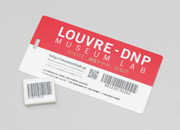 |
|
|
|
|

